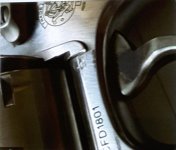You are using an out of date browser. It may not display this or other websites correctly.
You should upgrade or use an alternative browser.
You should upgrade or use an alternative browser.
Cylinders touching frame
- Thread starter lkabug
- Start date
Register to hide this ad
A picture showing what you mean would help a lot. I'm not sure I understand where the rub is happening.
If the rear outside of the cylinder is rubbing the frame in front of the lug that keeps the cylinder from moving to the rear when ejecting there is a problem with your yoke, probably the tube is out of line.
The photo looks like what Steelslayer is talking about. I believe S&W can fix it, but they might charge you if they determine it was caused by mishandling.
Arquebus357
Member
ACORN
Member
Just a WAG but I think the crane is bent. Perhaps someone(not You) was into slapping the cylinder open Hollywood style.
Protocall_Design
Member
Looking at the evidence presented, it looks like the crane just rotates a little too far on the pivot point.
Arquebus357
Member
Just a WAG but I think the crane is bent. Perhaps someone(not You) was into slapping the cylinder open Hollywood style.
Yes..It does sound like that, but there would be some wobble of the cylinder. There is NONE. Everything is tight and square. I wish you could handle this revolver yourself. This is the revolver in question. A $250 turn-in gun heavily modified by myself. (look closely and you can see the little step)

Yes..It does sound like that, but there would be some wobble of the cylinder. There is NONE. Everything is tight and square. I wish you could handle this revolver yourself. This is the revolver in question. A $250 turn-in gun heavily modified by myself. (look closely and you can see the little step)

Excellent repair for stainless. But it doesn't have to be a noticeable step. The silver braze can be flat and tapered to the outside edge of the yoke 'shelf'.
Blued guns are more of a challenge.
Pre war frames had a cyl detent hold open device from the very first hand ejectors, the .32 HE Model 1896, the 44 Triple Lock, etc. If you ever had a cyl flop closed while loading or unloading, it's a nuisance. Especially if you've become accustomed to shooting and handling pre war Smiths.
It's a bit of panache that disappeared after WWII for cost savings.

Notice the dimple in the yoke pivot. In my opinion installation of the detent pin and spring is the best way to keep a cyl from rubbing the frame, plus it adds a neat feature to any hand ejector.
These are too easy to make to hunt for the parts. Drill the hole in the yoke hinge with a # 37 drill bit to a depth that almost goes thru the yoke, and cut the shank off of a #38 drill bit that slips easily into the hole in the yoke. For K or N frame pins are in the .540” to .570” length range and dome SHAPE one end. Use a BIC lighter spring cut to about ½”.
Install spring and pin with domed end out. You can experiment with different spring lengths for just the right tension. If the yoke pivots too tightly cut a coil or two off the spring.
Use a sharpie pen to blacken the frame side of the hinge. Install the yoke/cyl assembly in the half way open position. Pivot the cyl open to a position that the cyl clears the frame where it rubbed, remove yoke/cyl assembly. Center punch and drill the dimple shown above at the end of the inscribed line in the black ink.
Last edited:
Arquebus357
Member
That would be a cool modification if I had the proper tools to make it happen. I would probably forget about it and when I removed the cylinder/yoke assembly from the frame the plunger would end up in low earth orbit along with some of my other parts.
Nice to know though. Thanks for this information
Nice to know though. Thanks for this information
Back in armorer school we were taught to peen the yoke button so that it would have more friction on opening until at full open there was enough to hold it open during reloading. Its really not all that hard to do after some practice. Even so, the factory did not do it, and I have only done it once or twice myself.
Back in armorer school we were taught to peen the yoke button so that it would have more friction on opening until at full open there was enough to hold it open during reloading. Its really not all that hard to do after some practice. Even so, the factory did not do it, and I have only done it once or twice myself.
Another case of some simple "Yankee ingenuity"!
The cyl would open normally until it got into the peened area at the end of its swing where it would snug up. What could be simpler. After 30 years you maybe install a new yoke retaining screw, big deal.
I agree, S&W would not do that, they have excellent gunsmiths but they will not do nothing outside the "box", except adjusting trigger pull.
Similar threads
- Replies
- 31
- Views
- 1K
- Replies
- 7
- Views
- 586


